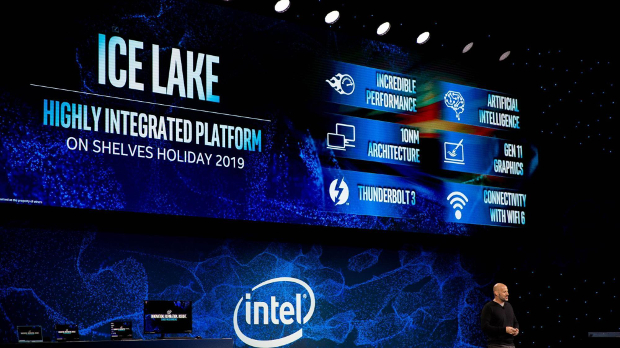
Intel will increase low-end CPU production now that its 10nm Ice Lake transition is complete
Prices of low-end PCs may fall once again, as Intel said Thursday that its shortage of small-core microprocessors is easing. Intel still faces an oversupply of Flash memory, which should help keep down the prices of SSDs and other Flash-based products.
Intel’s second-quarter results, reported Thursday, exceeded the company’s own expectations. Intel profits were down 17% to $4.2 billion, while revenue fell slightly by 3% to $16.5 billion. In part, that’s because of inventory and manufacturing bumps as the company transitioned to its 10nm products, including Ice Lake, which Intel has said previously is now shipping.
Intel now has two 10nm factories manufacturing silicon, chief executive Bob Swan said. Intel’s overall manufacturing slowed while those factories ramped up, which the company described in previous earnings calls. According to Swan, Intel lost a “little bit of share” during the second quarter, as the company prioritised its higher margin, big core microprocessors. During that time, Swan said, Intel was unable to meet demand for its cheaper chips.
In 2021, Intel expects to transition to the 7nm manufacturing process node, an aggressive change of pace that will put Intel back on the pace of change defined by Moore’s Law, Swan said. By his estimation, Intel’s 7nm process will be competitive with the 5nm process technology he expects Intel’s rivals to be using by then.
Though Swan said that Intel’s second-quarter performance was better than its own expectations, Swan said he’s still worried by the Trump Administration’s ongoing tariff was with China, as well as the uncertainty concerning the Dept of Commerce entity list. During the quarter, the US government placed Huawei, a major Chinese technology company, on the Commerce entity list, essentially forbidding US companies from doing business with it. Later, five Chinese supercomputer firms joined the list. Swan didn’t name Huawei or the other firms by name, but he did say that uncertainty over the China situation “makes me a little more anxious”.
Intel’s PC-centric client computing group still represents the majority of Intel’s revenue, with the division reporting 1% more revenue, $8.8 billion, than the same quarter a year ago. Intel’s data centre group reported $5 billion in revenue, down 10% in the face of stronger competition from AMD and its Epyc chips. Intel also owns a number of smaller businesses, including its automonous driving group, MobileEye ($201 million in revenue, up 16%), and its programmable solutions group, which recorded $489 million in revenue, down 5%.
Unsurprisingly, Intel sold off its 5G smartphone modem business to Apple for about $1 billion, after Apple was forced into a supply deal with Qualcomm because of Intel’s reported inability to meet production targets.
Intel’s Swan didn’t say anything about Intel’s ongoing work to develop its discrete graphics chips, let alone reference AMD or Nvidia, its chief rivals. AMD, which is engaged in a GPU dogfight with Nvidia and in CPUs with Intel, reports on 30 July.
IDG News Service







Subscribers 0
Fans 0
Followers 0
Followers